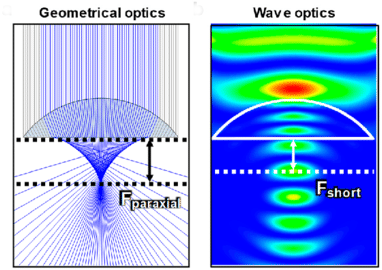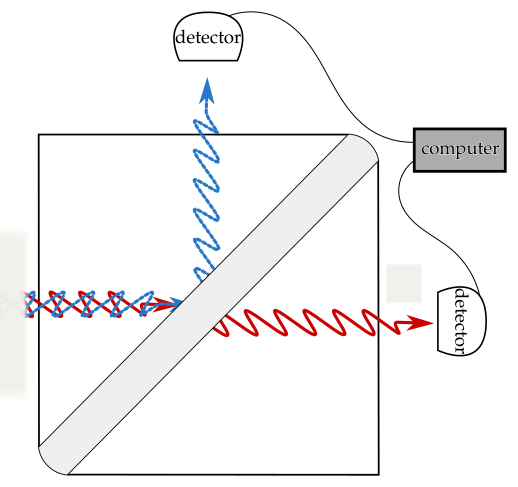Quantum Information Geometry
Konrad Szymański
RCQI Bratislava
Quantum mechanics primer

Lee, G. J. et al., Micromachines 2020.
- Einstein: light is photons — 'wave components', each with definite energy and wavelength.
- de Broglie: … maybe electrons are similar? (yes!)
-
Schrödinger: insight from the limit
wave optics \(\rightarrow\) ray optics, `electron wave' described by \(\ket{\psi(t)}=\psi(x,y,z,t)\), \[i \frac{\partial \ket{\psi}}{\partial t} \!=\! \overbrace{\left(\!-(\partial^2_x\!+\!\partial^2_y\!+\!\partial^2_z)\!+\!\frac{k}{\sqrt{x^2\!+\!y^2\!+\!z^2}}\!\right)}^{H} \ket{\psi}\] - Quantum information: restricted linear subspaces of $\ket{\psi}$:\[\ket{\psi} = c_1 \ket{\psi_1} +\ldots+c_d \ket{\psi_d}.\]
What is measurement?

- Coupling between the system and the outside world: \[i\frac{\partial \ket{\psi}}{\partial t} = (H_{\text{sys}}\otimes\operatorname{Id} + \operatorname{Id}\otimes H_{{world}} + H_{\text{int}} ) \ket{\psi}\]
- Parts separate in space: clear interpretation!
- Result (in the simplest case): \(\exists\) orthonormal bases \(\color{blue}\{\ket{e_i}\}\) and \(\color{green}\{\ket{f_j}\}\) such that \[\left.\ket{\psi}\right|_{t=0}=\left(\sum {\color{red}c_k}{\color{blue}\ket{e_k}} \right)\otimes \ket{w} \mapsto\sum {\color{red}c_k} {\color{blue}\ket{e_k}} \otimes {\color{green}\ket{f_k}} =: \left. \ket{\psi}\right|_{t\rightarrow \infty}\]
- Born interpretation: probability \(\propto~\)norm\(^2=\lvert {\color{red}c_k}\rvert^2\) .
- We don't know the details!
What is measurement?
Observations are discrete, single observation \(\approx\) element of the basis \(\{\ket{e_k}\}\). Often an eigenbasis of some physically relevant operator \(A\): \[A=\sum \lambda_k \ket{e_k}\bra{e_k}.\]
(\(A\) Hermitian, real eigenvalues)
- `Moments of \(A\)' inferred from observation
statistics. Expectation value: \[E(A) = \braket{\psi\vert A\vert\psi}
\color{gray} =\sum_k \frac{n_k}{\sum_j n_j}
\lambda_k.\]
(with $\ket\psi=(\psi_1,\ldots, \psi_d)^T$, $\langle \psi \vert A \vert \psi \rangle = \sum_{i,j=1}^d \psi_i^* A_{i,j} \psi_j$)
State vectors are not the entire story
What if the black box generates \(\ket{\psi_k}\) according to the ensemble \(\{(p_k,\ket{\psi_k})\}\)?
Qubit example:
$$ X = \begin{pmatrix} 0 & 1 \\ 1&0 \end{pmatrix},~ Y = \begin{pmatrix} 0 & -i \\ i & 0 \end{pmatrix}, ~Z=\begin{pmatrix} 1 & 0 \\ 0&-1\end{pmatrix}.$$
With $\ket\psi = \begin{pmatrix} \cos\frac\theta2\\e^{i\phi} \sin\frac\theta2\end{pmatrix},$ $$ \vec r=\begin{pmatrix} \langle X\rangle\\\langle Y\rangle\\\langle Z\rangle\end{pmatrix}=\begin{pmatrix}\cos\phi\sin\theta\\\sin\phi\sin\theta\\\cos\theta\end{pmatrix}, \Vert \vec r \Vert =1 $$ But if $\ket0, \ket1$ are taken at random, $\Vert \vec r\Vert =0$!Mixed states are statistical averages
- Expectation value linear: \[\sum p_k \braket{\psi_k \vert A\vert \psi_k}=\operatorname{Tr} A \overbrace{\sum p_k \ket{\psi_k} \bra{\psi_k}}^{\rho}\]
- Definition
(mixed states of dimension \(d\)): \[\mathcal{M_d} =
\{ \rho \in \mathbb{C}^{d\times d} : \rho=\rho^\dagger,
\operatorname{Tr} \rho=1, \rho \succeq 0\}.\]
$X\succeq 0$: positive semidefinite matrix
$\Leftrightarrow X=\sum x_k \ket{\psi_k}\bra{\psi_k}$ with positive $x_k$. - All properties defined by \(\rho\). Details of the ensemble do not matter!
- Tomography: reconstruction of \(\rho\) from measurement statistics.
Numerical ranges: projections of state space
Definition (joint numerical range): \[W(A_1, \ldots, A_n) \\= \{ (\langle A_1\rangle_\rho ,\ldots, \langle A_n \rangle_\rho) : \rho \in \mathcal{M} \}\]
\(A_i\) Hermitian: observations related to orthogonal eigenbases.
Expectation values $\langle A_i\rangle$ real.
$W(X)$: all possible expectation values
$$W(X)=[\lambda_{\min}(X),\lambda_{\max}(X)]$$$W(X_1, X_2)$: all possible tuples of expectation values
$W(X_1, X_2, X_3)$: triples

Numerical ranges geometry: cuts through state space
$\vec n \in S^\circ$: $\max_{\vec x \in S}\vec n\cdot\vec x \le 1$ – convex duality
Polynomial theory!
Uncertainty relations
- Variance: also inferred from observation statistics, \[\operatorname{Var}(A)=E(A^2)-E(A)=\braket{\psi\vert A^2\vert \psi}-(\braket{\psi\vert A\vert \psi})^2.\]
- Given two measurements $A$ and $B$, what is the relation between variances?
- The Heisenberg uncertainty relation: \[\operatorname{Var}(X) \operatorname{Var}(P) \ge \frac14,\] for \[(X {\psi})(x)=x {\psi}(x), (P {\psi})(x) = -i\left.\frac{\partial}{\partial x}{\psi}\right|_{x}\]
Variance can be encoded in 2D numerical range
With \((x,x')~\in~W(X,X^2),\) \(\operatorname{Var}(X)=x'-x^2.\)
Sum of variances: 3D joint numerical range
($SU(2)$ metrology)
Precise measurements of magn. field strength $B$.
Measurement precision bound by variances, $$ \Delta^2(B) \le C\times({\operatorname{Var}(X) +\operatorname{Var}(Y)}),$$ for specific $X$ and $Y$.Observation: minimal sum on variances attained on the surface of \(W(X,Y,X^2+Y^2)\), tangent to the paraboloid of revolution.
Summary
- Different definition of sets of quantum states help in some cases.
- Numerical ranges (possible tuples of expectation values) are their projections.
- Interesting polynomial theory connection through Kippenhahn theorem.
Thank you for your attention!
- K.S., Numerical ranges and geometry in quantum information: Entanglement, uncertainty relations, phase transitions, and state interconversion (PhD thesis), arXiv: 2303.07390,
- K.S., S. Weis, K. Życzkowski, Classification of joint numerical ranges of three hermitian matrices of size three, LAA 2018,
- T. Simnacher, J. Czartowski, K.S., K. Życzkowski, Confident entanglement detection via the separable numerical range, PRA 2021,
- K.S., K. Życzkowski, Geometric and algebraic origins of additive uncertainty relations, J Phys A 2019,
- Lee, G. J. et al., Micromachines 2020.
- J. Xie et al., PRL 2020
References:
Correlation between different parts of the system
- State of two systems: \(\rho\in
\mathcal{M}_{d_1\times d_2}\)
(\(\rho=\) convex combination of projectors onto subspaces in \(\mathcal{H}_{d_1}\otimes\mathcal{H}_{d_2} \))
- No correlation at all: \(\rho = \rho' \otimes \rho''\)
- Any non-tensor \(\rho\): correlation when measuring two subsystems!
- Definition (separable states of bipartite \(\mathcal{H}_{d_1}\otimes\mathcal{H}_{d_2}\)): \[ \mathcal{M}^{\text{sep}}_{d_1,d_2} = \operatorname{conv}\{ \Pi_{\ket{v_k'}}\otimes \Pi_{\ket{v_k''}}: \ket{v'}\in\mathcal{H}_{d_1}, \ket{v''}\in\mathcal{H}_{d_2}\} \]
- \(\mathcal{M}^{\text{sep}}_{d_1,d_2}\) allows for
correlations… but not all of them!
\(\mathcal{M}^{\text{sep}}_{d_1,d_2}\) is a proper convex subset of \(\mathcal{M}_{d_1\times d_2}\).
Entanglement and separable numerical ranges
Joint numerical range vs separable numerical range
- \(W_{\text{sep}}=\{\vec a \in \mathbb{R}^n | a_i = \operatorname{Tr} \rho A_i, \rho \in \mathcal{M}^{\text{sep}}\}\)
- Expectation values outside \(W_{\text{sep}}~\implies\) entanglement!
- \(W_{\text{sep}}\) convex \(\implies\) defined by linear constraints.
- Approximation by half-space intersection in
general NP-hard!
S. Friedland, L-H. Lim, Nuclear Norm of Higher-Order Tensors, Math. Comp. 2014
Entanglement and separable numerical ranges
Goal: maximize \(\operatorname{Tr} X(\rho'\otimes \rho'')\) over \( \rho'\in\mathcal{M}_2, \rho''\in\mathcal{M}_d \).
Lemma:
Optimization reduces to finding a point on the surface
of 4D joint numerical range, tangent to a
hypercone.
Main points:
- \( \operatorname{Tr} X (\rho'\otimes \rho'')=\operatorname{Tr} \rho' X''\), where \[X''=\operatorname{Tr}_2 X (\operatorname{Id} \otimes \rho'')\]
- For \(\rho''\) fixed, \[\max_{\rho'} \operatorname{Tr} \rho' X'' = \lambda_{\max}(X'').\]
- \(X'' \in M_{2\times 2} \implies \) for \(X_i=\operatorname{Tr}_1 X(\sigma_i\otimes \operatorname{Id})\), \[\lambda_{\max}(X'')=x_0+\sqrt{x_1^2+x_2^2+x_3^2}\]
- Linearization possible: then semidefinite programming.